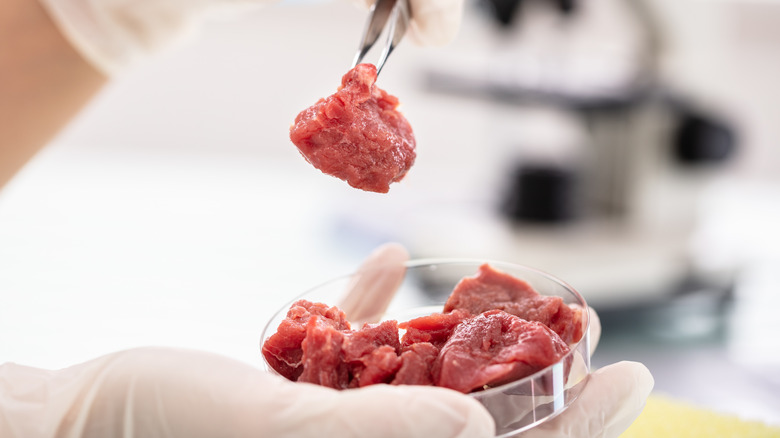How To Tell If Your Meat Has Gone Bad
Have you ever paused in front of the refrigerator, eyeing a cut of meat and wondering if it's still good to cook? Knowing where your meat comes from and watching for signs of spoilage, such as changes in color, smell, or texture, can help you determine if it's safe to eat. According to the Centers for Disease Control and Prevention, each year in the United States, 48 million people get sick from foodborne illnesses. Meat is a fertile breeding ground for bacteria that cause them. Diligent cooking may not be a good enough preventive measure as toxins produced by certain bacteria can survive heating.
During the journey of meat from farm to table, several opportunities exist for contamination with harmful bacteria such as salmonella or campylobacter. These pathogens can originate from the intestines of healthy animals and find their way onto the meat during processing. If the meat is not adequately refrigerated, or if cross-contamination occurs, the bacteria can multiply, especially as the meat begins to spoil. Ground beef, for example, can be perilous due to the possible presence of harmful bacteria like salmonella and shiga toxin-producing E. coli, which can be lethal. These bacteria thrive in an environment where the meat has been left at room temperature, allowing them to multiply rapidly in spoiled food.
Visual inspection
Color is a prominent indicator of freshness across various types of meat. The ideal color for fresh beef is bright, cherry-red, while lamb's is slightly darker. Raw chicken is usually lighter pink with white fats. Raw fresh pork should also exhibit a pink color that may be slightly purple when just cut. When meat takes on a greenish tint, it's an unmistakable sign that it should be discarded. Mold growth, visually characterized by slime or white patches, especially on red meats, is also an indicator of spoilage, particularly when the meat has been exposed to air for an extended period of time.
The outer part of pre-packed ground beef may appear red, while the inside could look somewhat brown. This color variance is attributable to differing degrees of exposure to oxygen. If the entire piece looks uniformly grey, discard it. In the case of processed meats such as sausages, hot dogs, and salamis, additives like color stabilizers can conceal spoilage. Thus, other signs like smell and texture must be observed. For fish, bright-looking meat signifies freshness, while a dull or faded appearance may indicate spoilage. If the meat is vacuum packed, any swelling or leakage could signify a problem; such signs should prompt caution.
Smell test
Even if the meat appears visually fine, an off smell can be an unambiguous sign of spoilage. Fresh fish and meat alike are characterized by a lack of noticeable odor. In contrast, spoilage often results in a strong or sour smell that is immediately noticeable. This change in odor occurs as bacteria grow, producing gases and compounds like ammonia and hydrogen sulfide. Moreover, Food Safety states that consumption of putrescine, a toxin that gives rotting meat its foul smell, may lead to poisoning symptoms such as heart palpitations, headaches, vomiting, and diarrhea.
Fresh beef typically carries a clean, iron-like smell, while poultry, such as chicken, should present a mild or neutral scent. Fresh fish will have a mild ocean-like fragrance and should not smell fishy at all; it might remind you of the clean, salty air at the beach. Fresh pork should exude a pleasant aroma, rather than an overpowering odor. Lamb's fresh scent is characterized by a light, mildly earthy odor, and processed meats sometimes carry the scents of seasonings without any sour or off smells.
Touch test
Changes in tactile sensations signal a transformation in the meat, posing health risks that can be mitigated if promptly recognized. If you run a finger over the meat or press it lightly and find that it has become slimy or unusually sticky, this is often a warning that the meat has begun to spoil. Sliminess or stickiness in meat can be attributed to the growth of various bacteria, molds, yeasts, and the mishandling of meat before and after slaughter. Do not consume meat that exhibits this condition as it may result in hospitalization or have fatal consequences such damage to the kidneys or brain, as warned by the CDC.
Fresh meat is typically firm and somewhat damp; it should spring back when pressed and maintain its shape. If the meat has lost its firmness, or has a slippery or spongy texture, or breaks apart easily under slight pressure in the case of ground meat, it is no longer good. Spoiled fish may become particularly soft and fall apart easily.
Packaging check
The 'use by' date is a critical indicator of a meat product's potential freshness, representing the final day that the product is expected to retain its optimal quality. While consuming the meat after this date doesn't necessarily mean it has spoiled, it does elevate the risk of spoilage and potential illness. The date is determined by factors such as the type of meat, processing method, and packaging.
Different packaging methods, such as standard butcher's paper or vacuum sealing, impact how meat reacts to exposure to air, a key factor in spoilage. Traditional butcher's paper allows more air to reach the meat, which may lead to faster spoilage; thus, meat wrapped this way should be consumed more quickly. In contrast, vacuum sealing or modified-atmosphere packaging is designed to extend shelf life by reducing air exposure and preserving freshness. This effectiveness, however, relies heavily on the integrity of the protective barriers used in these methods. If they are compromised, contamination can occur. For example, bloated packaging may signal gas production from bacterial activity, a sign of packing contamination and spoilage. Any compromises to the packaging, such as holes or weak seals, expose the meat to bacteria, air, and moisture, accelerating degradation.
Consideration of meat type
Different types of meat exhibit unique characteristics and spoilage rates, requiring careful evaluation. For example, the freshness of fish can often be assessed by the appearance of its eyes, which should be clear and vibrant, a sign that may not apply to other meats." Seafood generally has a shorter shelf life compared to poultry or red meats such as beef.
Understanding the specific cut of meat and its fat content is also vital for evaluating its durability. Fattier cuts like ribeye steak or pork belly are more prone to developing a rancid smell quickly, owing to fat oxidation, a process detailed in a 2018 study. In contrast, leaner cuts such as chicken breast or pork loin may spoil more slowly due to their lower fat content.
A 2020 study highlights how cuts from more active regions of the animal, like the leg, might spoil differently in texture compared to stationary muscles like the loin. Therefore, when evaluating different cuts of meat, it is essential to consider whether the cut is from an active or stationary region, as spoilage signs may vary between the two.
Professional advice
In-house butchers or knowledgeable store staff are often the go-to experts for assessing meat freshness. With hands-on experience handling various types of meat, these professionals have a keen understanding of what fresh meat should look, smell, and feel like. If you find yourself in doubt, don't hesitate to approach the butcher at your local store. Simply inquire about the cut, its appearance, and any special characteristics you should be aware of. A butcher's advice may include tips on selecting the right cut for your dish, recognizing freshness through color and texture, and guidelines for proper storage.
If an in-person examination isn't feasible, it's time to utilize technology. Describing or showing a picture of the meat to a professional online can still yield valuable advice. Begin by capturing a clear image of the meat, focusing on color, texture, and any questionable areas. Next, find a reputable online butcher or culinary forum where professionals gather and offer insights. Engage in the community by describing the meat's appearance, smell, and any concerns you may have in detail, and then await feedback.






